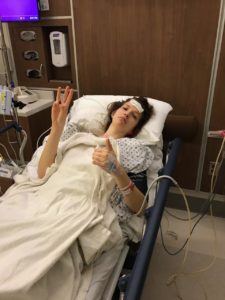Diagnosed at 23
Gabrielle
Story Written by Author/Self
 My story really only began a few years ago. I lived a healthy, seemingly normal life up until the age of 23. I was a dancer since the age of two and a half, competing on my studio’s dance team, as well as being a member of my high school’s team and university’s team. I had no real medical issues during this time. I began experiencing constant dull headaches, pain, and pressure behind my eyes beginning during the summer of 2013, before my senior year of college. The pain was pretty faint, so I didn’t think too much of it. I thought that glasses might help, but in the end, that was not the answer. I went on to graduate college enrolling in mortuary school to follow my passion of becoming a funeral director. An intense one-year program, followed by a one-year residency in the funeral home. While I excelled in school, my symptoms worsened with no answer from my doctor. I was told to add more salt to my diet. That didn’t help. I was told maybe it was related to stress and that yoga classes might prove helpful. Still, nothing seemed to be working. My sinuses were another possible cause. I had a CT scan and nothing came of it. I simply went on and pushed through.
My story really only began a few years ago. I lived a healthy, seemingly normal life up until the age of 23. I was a dancer since the age of two and a half, competing on my studio’s dance team, as well as being a member of my high school’s team and university’s team. I had no real medical issues during this time. I began experiencing constant dull headaches, pain, and pressure behind my eyes beginning during the summer of 2013, before my senior year of college. The pain was pretty faint, so I didn’t think too much of it. I thought that glasses might help, but in the end, that was not the answer. I went on to graduate college enrolling in mortuary school to follow my passion of becoming a funeral director. An intense one-year program, followed by a one-year residency in the funeral home. While I excelled in school, my symptoms worsened with no answer from my doctor. I was told to add more salt to my diet. That didn’t help. I was told maybe it was related to stress and that yoga classes might prove helpful. Still, nothing seemed to be working. My sinuses were another possible cause. I had a CT scan and nothing came of it. I simply went on and pushed through.
In October of 2016, my symptoms were progressing and I pushed for an appointment to see a neurologist. He sent me for an MRI, after which I sat with him to review the results. He downplayed my symptoms and tried to categorize me quickly. He did not allow time for me to share my thoughts and concerns. You could definitely tell he did not want to be there or take the time to listen to me. He said, and I quote, “These headaches are the most common thing I treat women for of your age” and simply prescribed me medication that “should help.” Well it did not help and my symptoms were worsening. These symptoms now included intense vertigo and lack of coordination. He tried upping the dosage of my prescribed medication by 50 mg a day. No changes occurred. I was up to 3 pills a day, with not even a slight improvement in how I felt. In one of my prior appointments, he stated that while I did have a small amount of visible Hydrocephalus, I shouldn’t be concerned at all because it must just be part of my normal anatomy. That did not sit well with me. I pushed and pushed back at him. I was advocating for myself, that something was not right here. Finally, he ordered a new MRI, much to his chagrin. His tune quickly changed. He was now talking spinal taps and neurosurgery immediately. You can surely see why I sought a second opinion and never returned to him.
But where to turn to now? Where I should have been all along. One of the best hospitals for neurology and neurosurgery in the country. But to get an appointment is like trying to get into to see the wizard! A hard feat, but with a lot of prayer and a whole lot of luck, I met with my current neurologist on St. Patrick’s Day 2016. Someone had canceled their appointment for that day, and I have no doubt that someone was looking out for me from above. I was finally properly diagnosed with Obstructive Hydrocephalus. Things moved fast from that point on. A few more MRIs were ordered and it was determined surgery was imminent. We were walked down the hall to the neurosurgeon’s office. Upon review of my scans they called us immediately and just 2 weeks later I was on my way to meet my soon-to-be neurosurgeon. After examination, I was informed surgery was set for just four days later and I was told I only had a few weeks before things would have gone downhill fast. There are a few rarities in my case. My obstruction is located in the Fourth Ventricle, when normally it is seen in the Third Ventricle. My age at diagnosis makes my case rare, as well. Usually this is seen in babies or elderly patients, but here I was an otherwise healthy 23-year-old young woman. The doctors have never been able to pin point when or how my Hydrocephalus originated, but they believe it had been developing for years. They could not believe how I was functioning and living like this. When I was shown my scans compared to “normal” brain for the first time, I couldn’t believe it either. My brain stem was completely compressed to the back of my skull and ventricles dilated, everything was out of place and fluid had been seeping into my brain tissue.
After my first Endoscopic Third Ventriculostomy (ETV) in April of 2016, I recovered fast and went on with life. My symptoms came creeping right back, though, just before my one-year surgery anniversary. I had to once again convince everyone around me something was not right. With invisible illnesses, it’s easy for others to doubt your pain. This is something I have come to know all too well. Nevertheless, after a month of ER visits, a horrible spinal tap experience, the “post-lumbar headaches” and a blood patch to resolve, I underwent my second ETV in May 2017. When I was visited by my neurosurgeon after surgery, I asked, “Was the hole closed?” She responded, “100%.” Surprise- both the hole and the burr hole that was drilled had completely scarred over. I wasn’t crazy. I told everyone, “See, I know my body.” They agreed. Again, I recovered fast. UNTIL my symptoms came roaring right back, this time only six months after surgery. My team and I were in agreement that my body has a tendency to heal very well which is good, but in this case, we did not want it to. The next step which we had tried to avoid, was for a Ventriculoperitoneal Shunt to be placed. This was done in December of 2017. I think deep down I always knew this would be my fate, but definitely not six months after my second brain surgery.

Every surgery and recovery shapes me more and more into the person I am destined to become. It shows me just how strong my mind and body can be when it is pushed beyond its limits. I have learned so much about myself through this journey over the past couple of years. This past brain surgery has by far been the hardest recovery both physically and mentally, but through sharing my journey I have gained such a community of fellow “Hydrowarriors” which has been the light in a dark room. Getting used to having this foreign device in my body, is something I struggle with daily. But I have to love it for keeping me alive every day, right? My shunt gives me a fighting chance each day to have the opportunity for a career and a family of my own one day and for that I’m eternally grateful. With each surgery and possibly future surgery down the line I am being given another chance at life and what an amazing gift to be given. My Hydrocephalus has played a role in shaping me into the person I am today and has changed my outlook on life. I heard someone once say, “Always play the best game with the cards you’ve been handed.” I try to do just that each and every day. My story could have ended short so many times, and though I may not know how many more brain surgeries lie ahead of me, here I am, family at my side, still standing strong, ready to take on whatever comes my way!
Tell us about your journey with hydrocephalus!
Share your story of hope and perseverance with us! We will feature the amazing individuals in our community who are living life to the fullest regardless of their condition! Stories are reviewed by our staff and posted on our website and through social media. Stories should be no more than 800 words long. Click here to submit your story today!
Let’s SHARE. Let’s CONNECT. Let’s raise AWARENESS! Let’s INSPIRE!
For questions, email: communications@hydroassoc.org with the subject line “Share Your Story”.
Become a Grassroots Advocate for Hydrocephalus today! Visit our Advocacy Action Center.
